Page 272 of 347
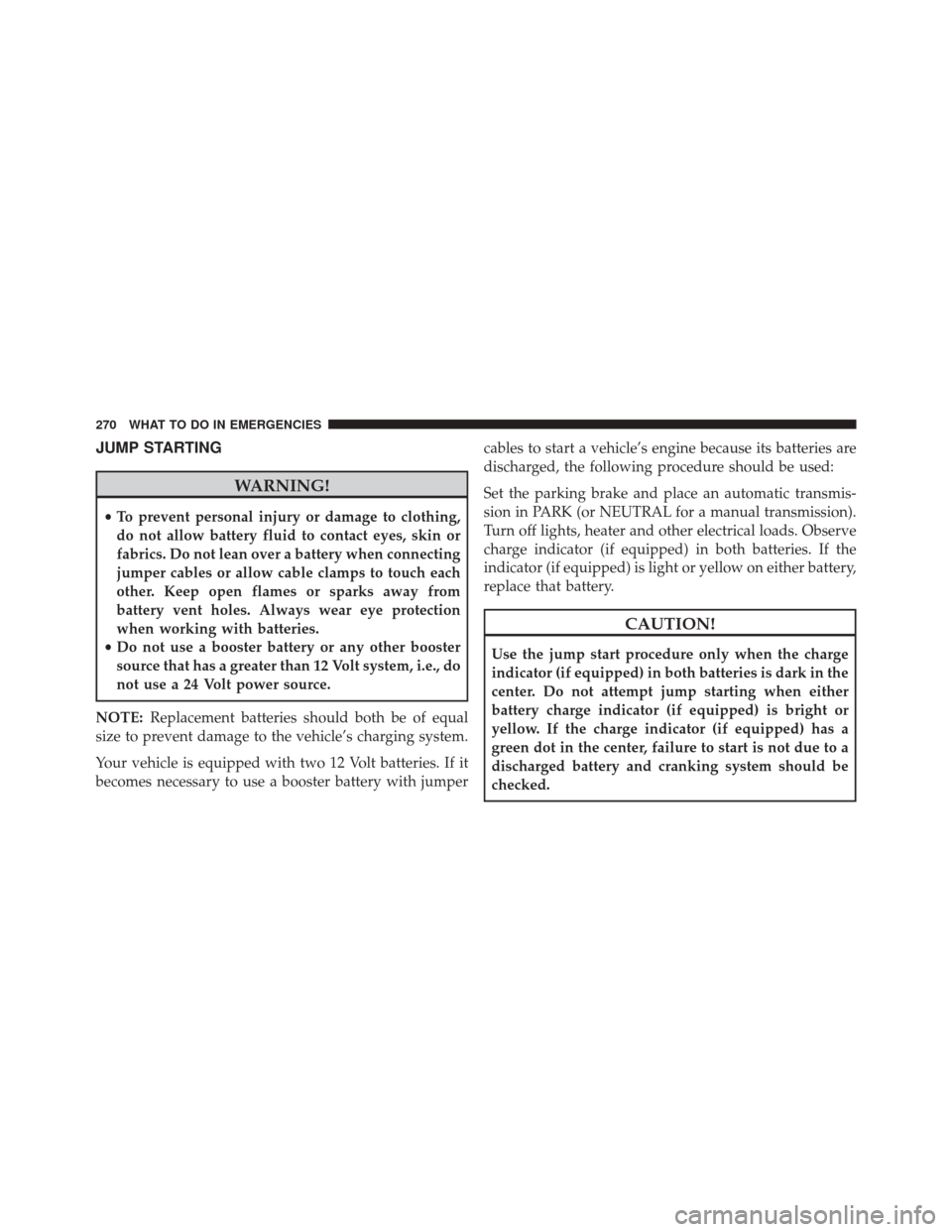
JUMP STARTING
WARNING!
•To prevent personal injury or damage to clothing,
do not allow battery fluid to contact eyes, skin or
fabrics. Do not lean over a battery when connecting
jumper cables or allow cable clamps to touch each
other. Keep open flames or sparks away from
battery vent holes. Always wear eye protection
when working with batteries.
• Do not use a booster battery or any other booster
source that has a greater than 12 Volt system, i.e., do
not use a 24 Volt power source.
NOTE: Replacement batteries should both be of equal
size to prevent damage to the vehicle’s charging system.
Your vehicle is equipped with two 12 Volt batteries. If it
becomes necessary to use a booster battery with jumper cables to start a vehicle’s engine because its batteries are
discharged, the following procedure should be used:
Set the parking brake and place an automatic transmis-
sion in PARK (or NEUTRAL for a manual transmission).
Turn off lights, heater and other electrical loads. Observe
charge indicator (if equipped) in both batteries. If the
indicator (if equipped) is light or yellow on either battery,
replace that battery.
CAUTION!
Use the jump start procedure only when the charge
indicator (if equipped) in both batteries is dark in the
center. Do not attempt jump starting when either
battery charge indicator (if equipped) is bright or
yellow. If the charge indicator (if equipped) has a
green dot in the center, failure to start is not due to a
discharged battery and cranking system should be
checked.
270 WHAT TO DO IN EMERGENCIES
Page 273 of 347
1. Attach one jumper cable to the positive terminal ofbooster battery and the other end of the same cable to
the positive terminal of the discharged battery.
NOTE: Do not jump off fuses. Only jump directly off
positive post.
WARNING!
Do not permit vehicles to touch each other as this
could establish a ground connection and personal
injury could result.
Battery (Diesel Model Shown)
1 — Positive Battery Post
2 — Fuses
5
WHAT TO DO IN EMERGENCIES 271
Page 274 of 347
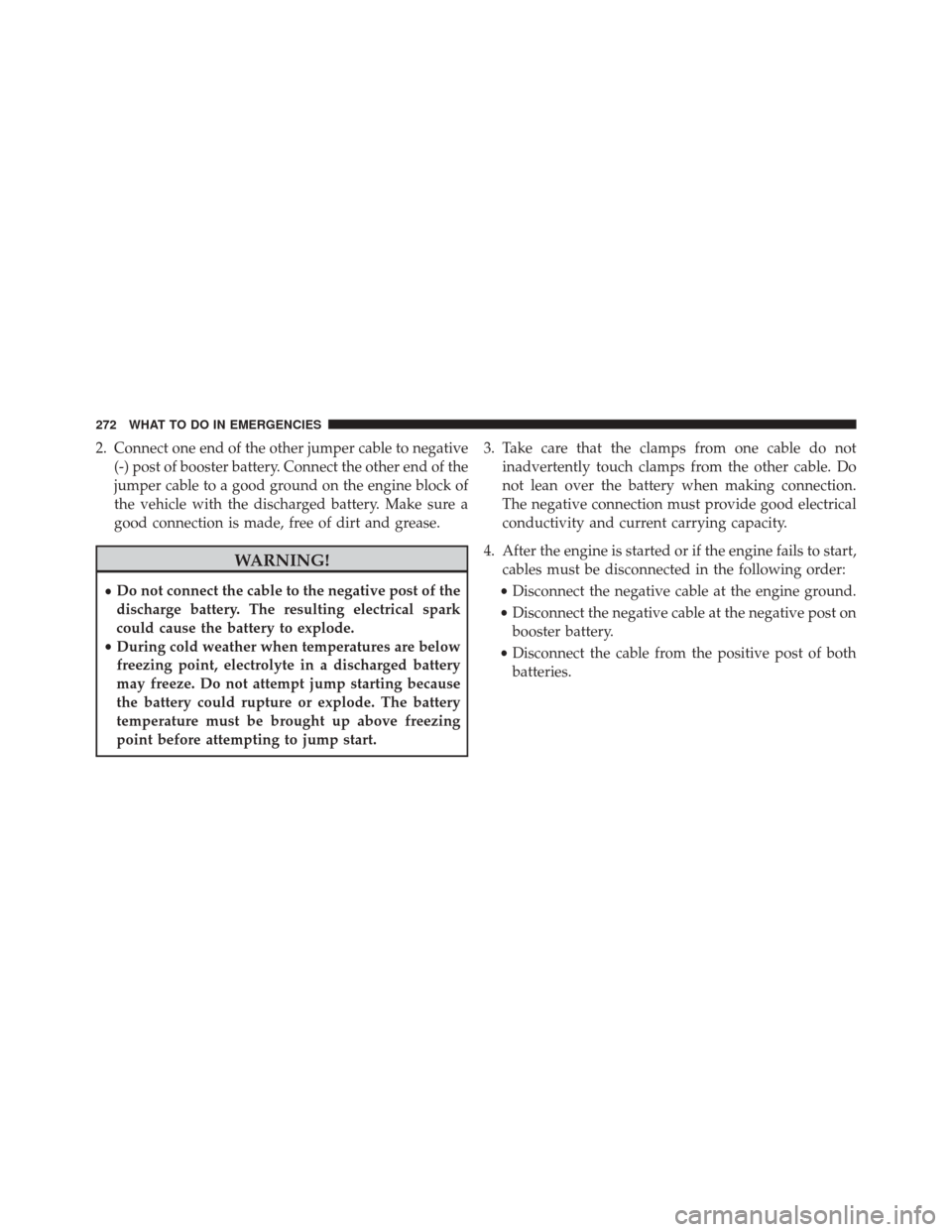
2. Connect one end of the other jumper cable to negative(-) post of booster battery. Connect the other end of the
jumper cable to a good ground on the engine block of
the vehicle with the discharged battery. Make sure a
good connection is made, free of dirt and grease.
WARNING!
•Do not connect the cable to the negative post of the
discharge battery. The resulting electrical spark
could cause the battery to explode.
• During cold weather when temperatures are below
freezing point, electrolyte in a discharged battery
may freeze. Do not attempt jump starting because
the battery could rupture or explode. The battery
temperature must be brought up above freezing
point before attempting to jump start. 3. Take care that the clamps from one cable do not
inadvertently touch clamps from the other cable. Do
not lean over the battery when making connection.
The negative connection must provide good electrical
conductivity and current carrying capacity.
4. After the engine is started or if the engine fails to start, cables must be disconnected in the following order:
• Disconnect the negative cable at the engine ground.
• Disconnect the negative cable at the negative post on
booster battery.
• Disconnect the cable from the positive post of both
batteries.
272 WHAT TO DO IN EMERGENCIES
Page 275 of 347
WARNING!
Any procedure other than above could result in:
•Personal injury caused by electrolyte squirting out
the battery vent.
• Personal injury or property damage due to battery
explosion.
• Damage to charging system of booster vehicle or of
immobilized vehicle.
With Portable Starting Unit
There are many types of these units available. Follow the
manufacturer’s instructions for necessary precautions
and operation.
CAUTION!
It is very important that the starting unit operating
voltage does not exceed 12 Volts DC or damage to
battery, starter motor, alternator, or electrical system
may occur.
5
WHAT TO DO IN EMERGENCIES 273
Page 286 of 347

Disposing Of Used Engine Oil And Oil Filters
Care should be taken in disposing of used engine oil and
oil filters from your vehicle. Used oil and oil filters,
indiscriminately discarded, can present a problem to the
environment. Contact your authorized dealer, service
station or governmental agency for advice on how and
where used oil and oil filters can be safely discarded in
your area.
Engine Air Cleaner Filter
CAUTION!
All air entering the engine intake must be filtered.
The abrasive particles in unfiltered air will cause
rapid wear to engine components.
WARNING!
The air induction system (air cleaner, hoses, etc.)
provides a measure of protection. Do not remove the
air induction system (air cleaner, hoses, etc.) unless
such removal is necessary for repair or maintenance.
Make sure that no one is near the engine compart-
ment before starting the vehicle with the air induc-
tion system (air cleaner, hoses, etc.) removed. Failure
to do so can result in serious personal injury.
The condition of the air cleaner filter is monitored by the
Engine Control Module. The “SERVICE AIR FILTER”
message will display in the Electronic Vehicle Informa-
tion Center (EVIC) or Driver Information Display (DID)
when service is required. Refer to “Electronic Vehicle
Information Center (EVIC)” or “Driver Information Dis-
play (DID)” in “Understanding Your Instrument Panel”
for further information.
284 MAINTAINING YOUR VEHICLE
Page 296 of 347
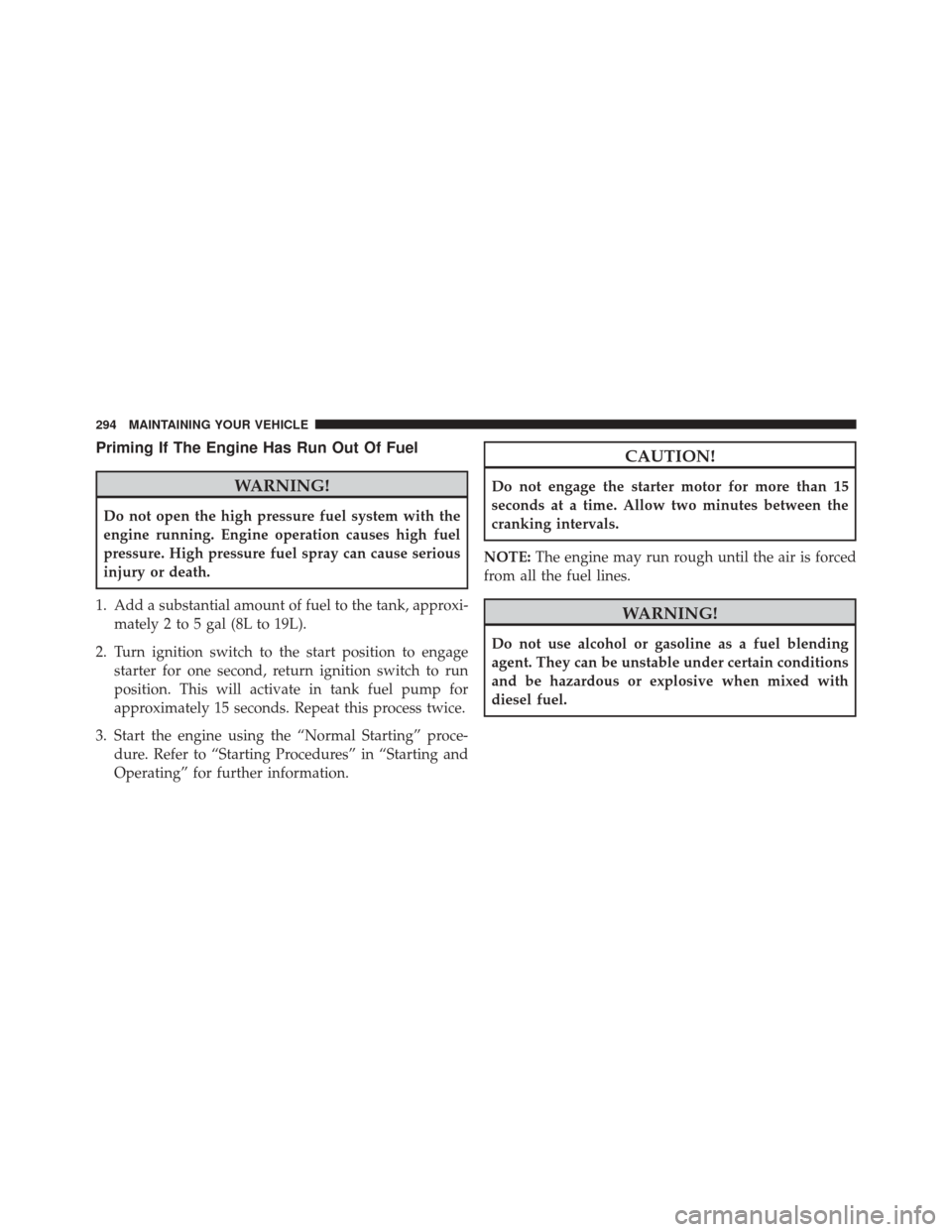
Priming If The Engine Has Run Out Of Fuel
WARNING!
Do not open the high pressure fuel system with the
engine running. Engine operation causes high fuel
pressure. High pressure fuel spray can cause serious
injury or death.
1. Add a substantial amount of fuel to the tank, approxi- mately 2 to 5 gal (8L to 19L).
2. Turn ignition switch to the start position to engage starter for one second, return ignition switch to run
position. This will activate in tank fuel pump for
approximately 15 seconds. Repeat this process twice.
3. Start the engine using the “Normal Starting” proce- dure. Refer to “Starting Procedures” in “Starting and
Operating” for further information.
CAUTION!
Do not engage the starter motor for more than 15
seconds at a time. Allow two minutes between the
cranking intervals.
NOTE: The engine may run rough until the air is forced
from all the fuel lines.
WARNING!
Do not use alcohol or gasoline as a fuel blending
agent. They can be unstable under certain conditions
and be hazardous or explosive when mixed with
diesel fuel.
294 MAINTAINING YOUR VEHICLE
Page 298 of 347
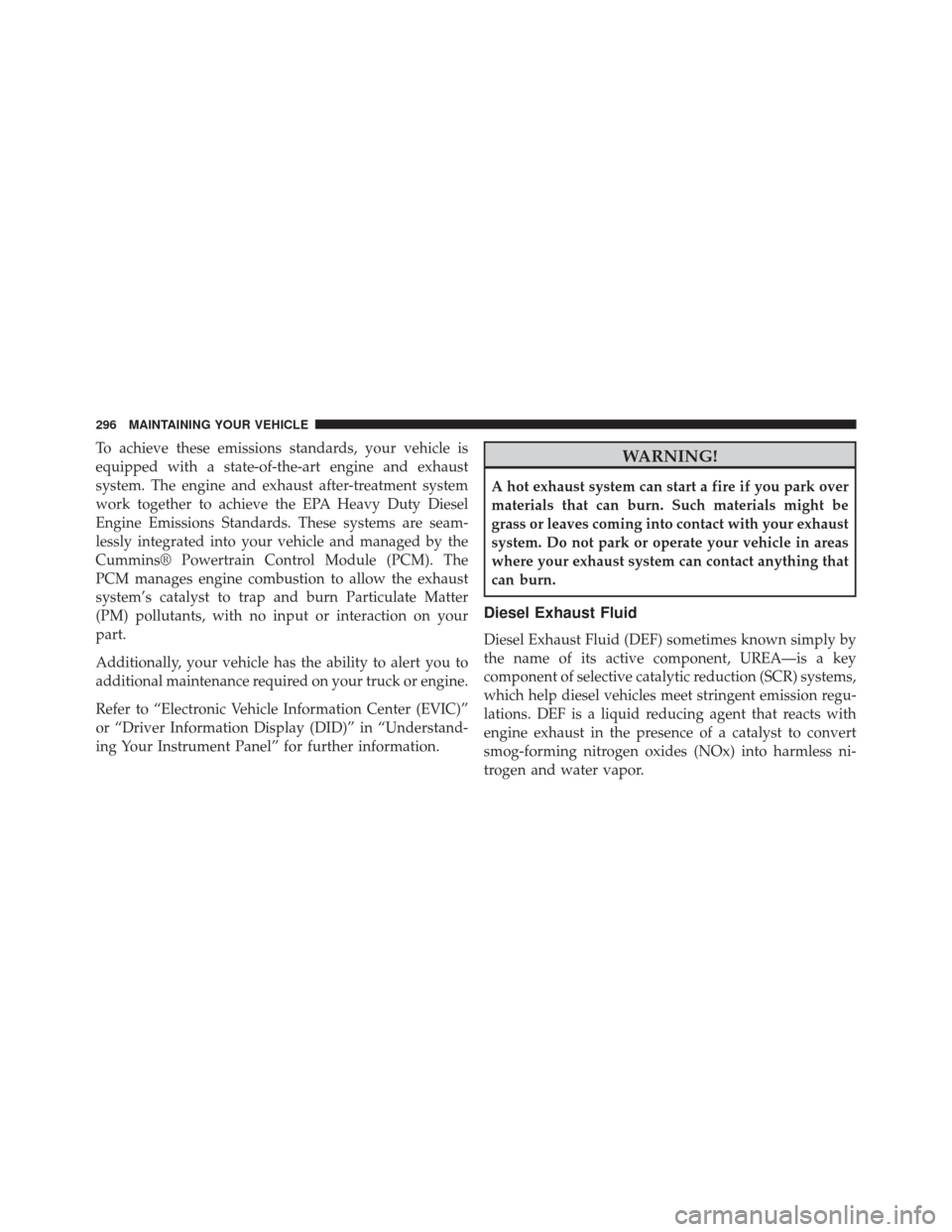
To achieve these emissions standards, your vehicle is
equipped with a state-of-the-art engine and exhaust
system. The engine and exhaust after-treatment system
work together to achieve the EPA Heavy Duty Diesel
Engine Emissions Standards. These systems are seam-
lessly integrated into your vehicle and managed by the
Cummins® Powertrain Control Module (PCM). The
PCM manages engine combustion to allow the exhaust
system’s catalyst to trap and burn Particulate Matter
(PM) pollutants, with no input or interaction on your
part.
Additionally, your vehicle has the ability to alert you to
additional maintenance required on your truck or engine.
Refer to “Electronic Vehicle Information Center (EVIC)”
or “Driver Information Display (DID)” in “Understand-
ing Your Instrument Panel” for further information.WARNING!
A hot exhaust system can start a fire if you park over
materials that can burn. Such materials might be
grass or leaves coming into contact with your exhaust
system. Do not park or operate your vehicle in areas
where your exhaust system can contact anything that
can burn.
Diesel Exhaust Fluid
Diesel Exhaust Fluid (DEF) sometimes known simply by
the name of its active component, UREA—is a key
component of selective catalytic reduction (SCR) systems,
which help diesel vehicles meet stringent emission regu-
lations. DEF is a liquid reducing agent that reacts with
engine exhaust in the presence of a catalyst to convert
smog-forming nitrogen oxides (NOx) into harmless ni-
trogen and water vapor.
296 MAINTAINING YOUR VEHICLE
Page 299 of 347
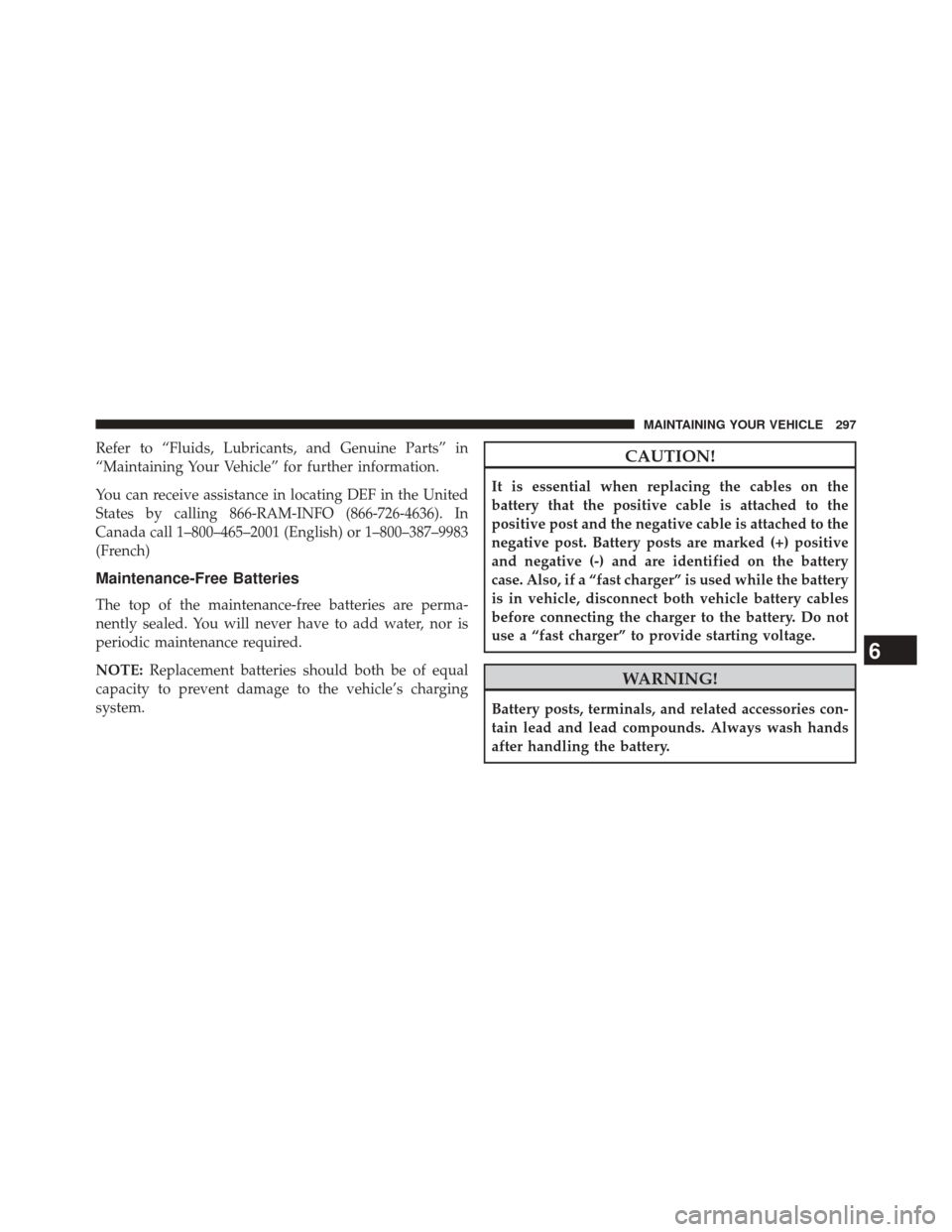
Refer to “Fluids, Lubricants, and Genuine Parts” in
“Maintaining Your Vehicle” for further information.
You can receive assistance in locating DEF in the United
States by calling 866-RAM-INFO (866-726-4636). In
Canada call 1–800–465–2001 (English) or 1–800–387–9983
(French)
Maintenance-Free Batteries
The top of the maintenance-free batteries are perma-
nently sealed. You will never have to add water, nor is
periodic maintenance required.
NOTE:Replacement batteries should both be of equal
capacity to prevent damage to the vehicle’s charging
system.
CAUTION!
It is essential when replacing the cables on the
battery that the positive cable is attached to the
positive post and the negative cable is attached to the
negative post. Battery posts are marked (+) positive
and negative (-) and are identified on the battery
case. Also, if a “fast charger” is used while the battery
is in vehicle, disconnect both vehicle battery cables
before connecting the charger to the battery. Do not
use a “fast charger” to provide starting voltage.
WARNING!
Battery posts, terminals, and related accessories con-
tain lead and lead compounds. Always wash hands
after handling the battery.
6
MAINTAINING YOUR VEHICLE 297